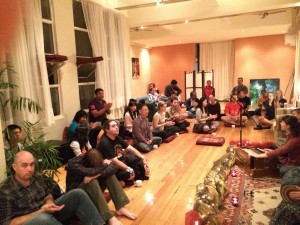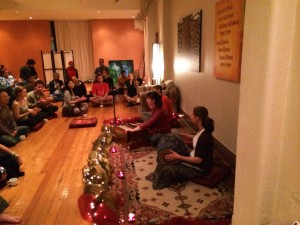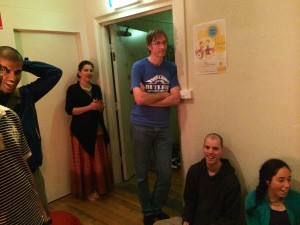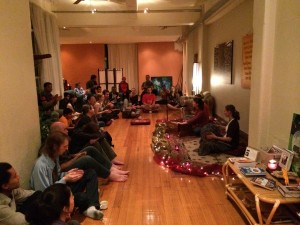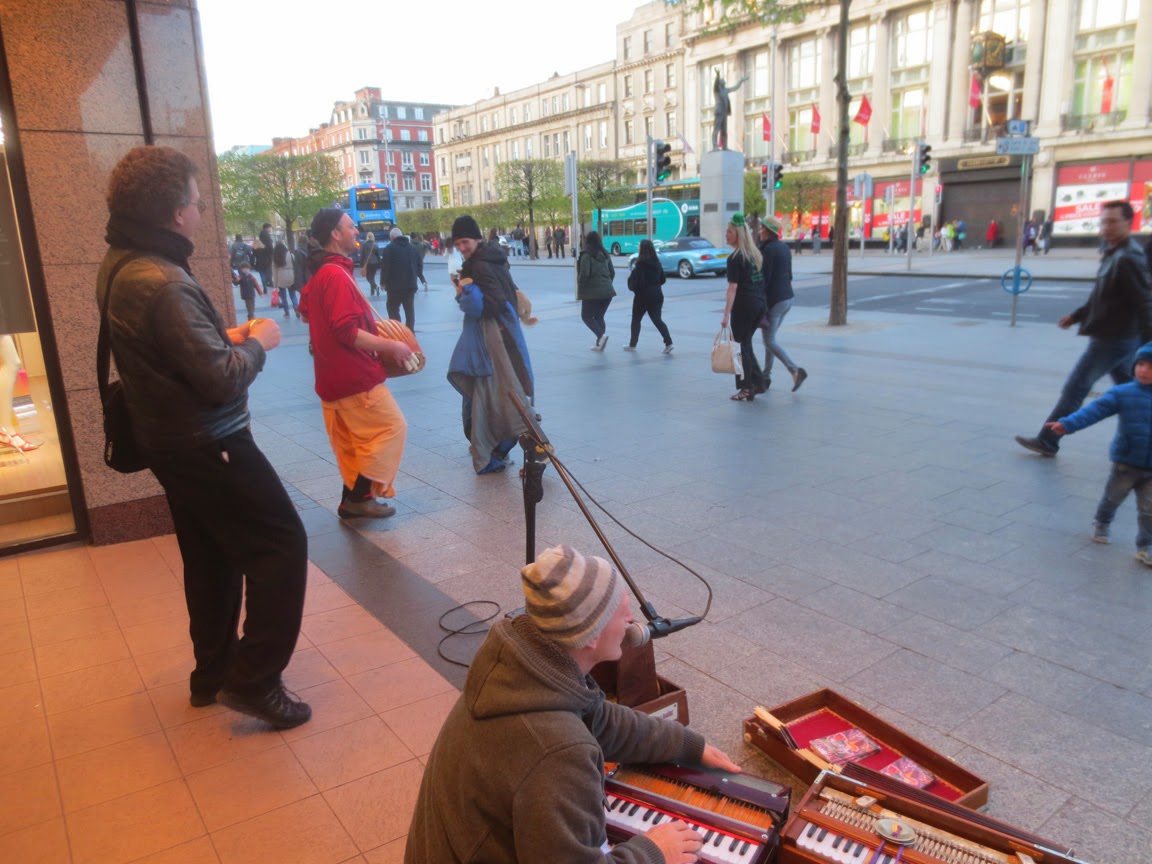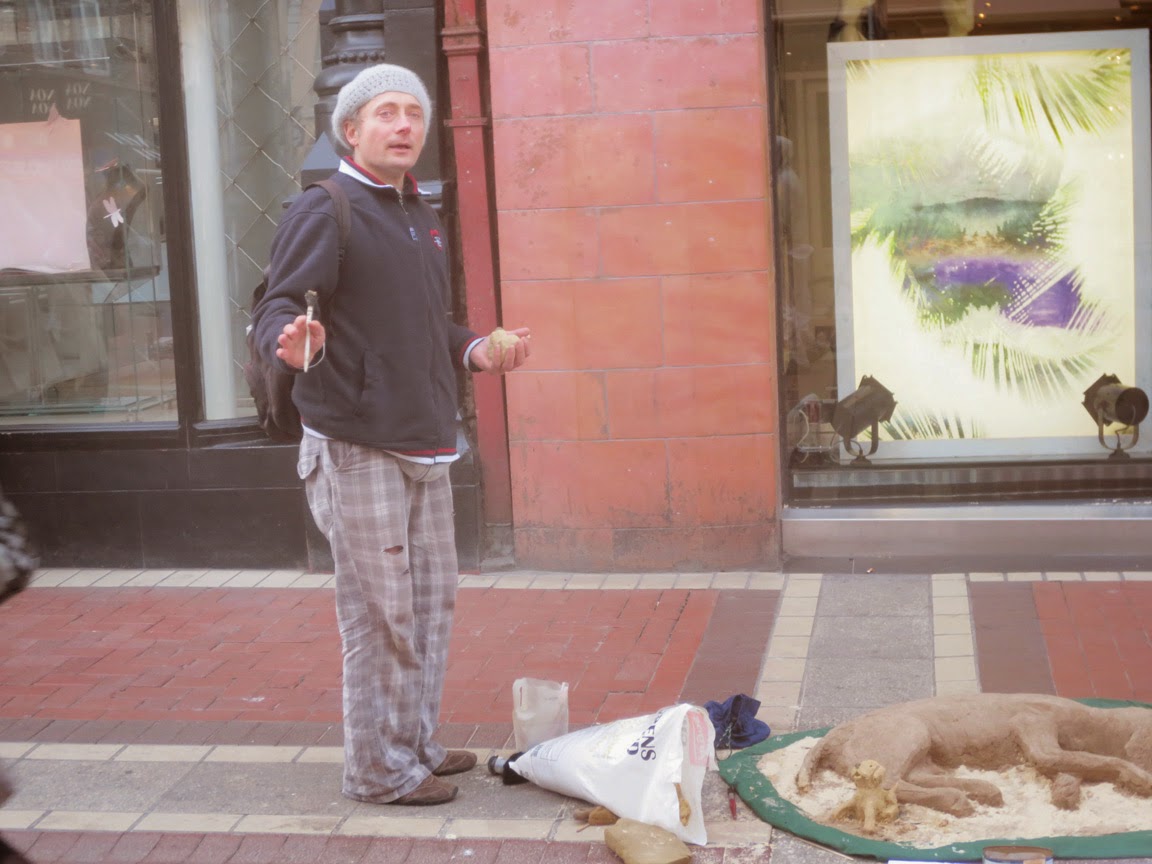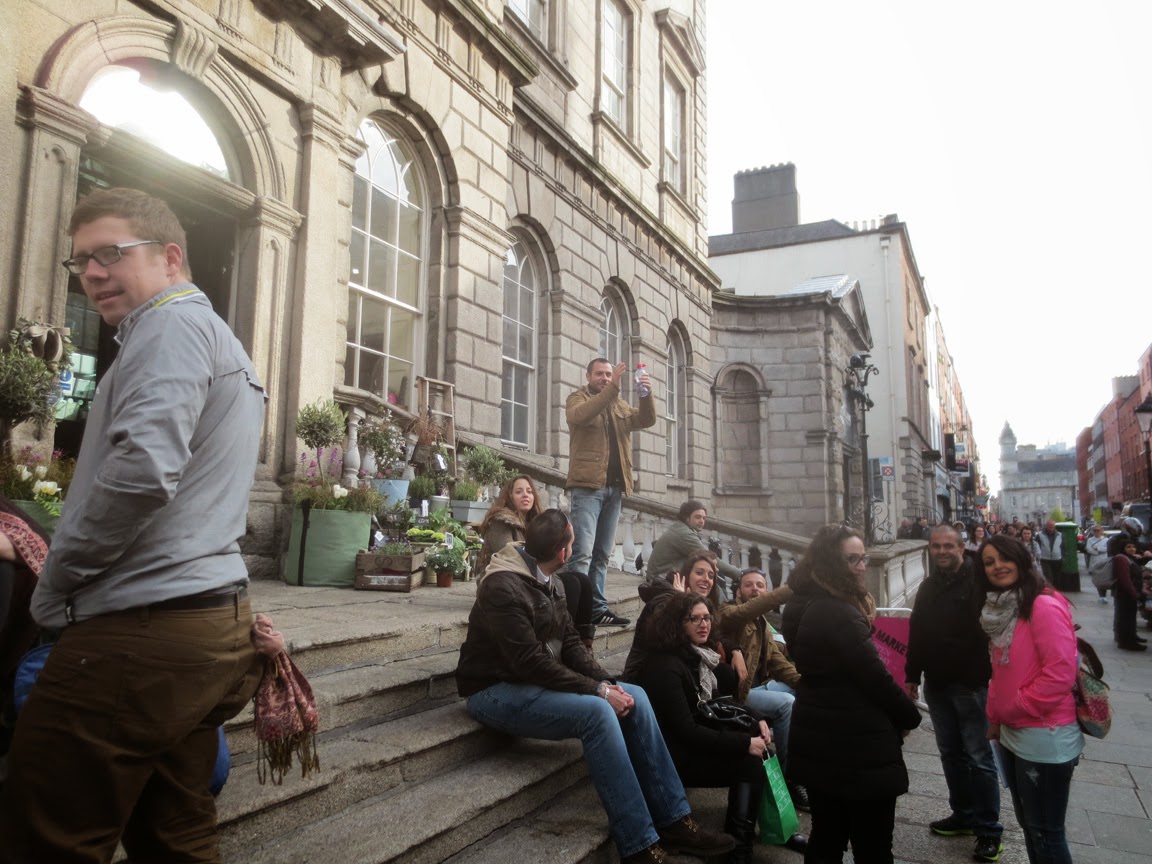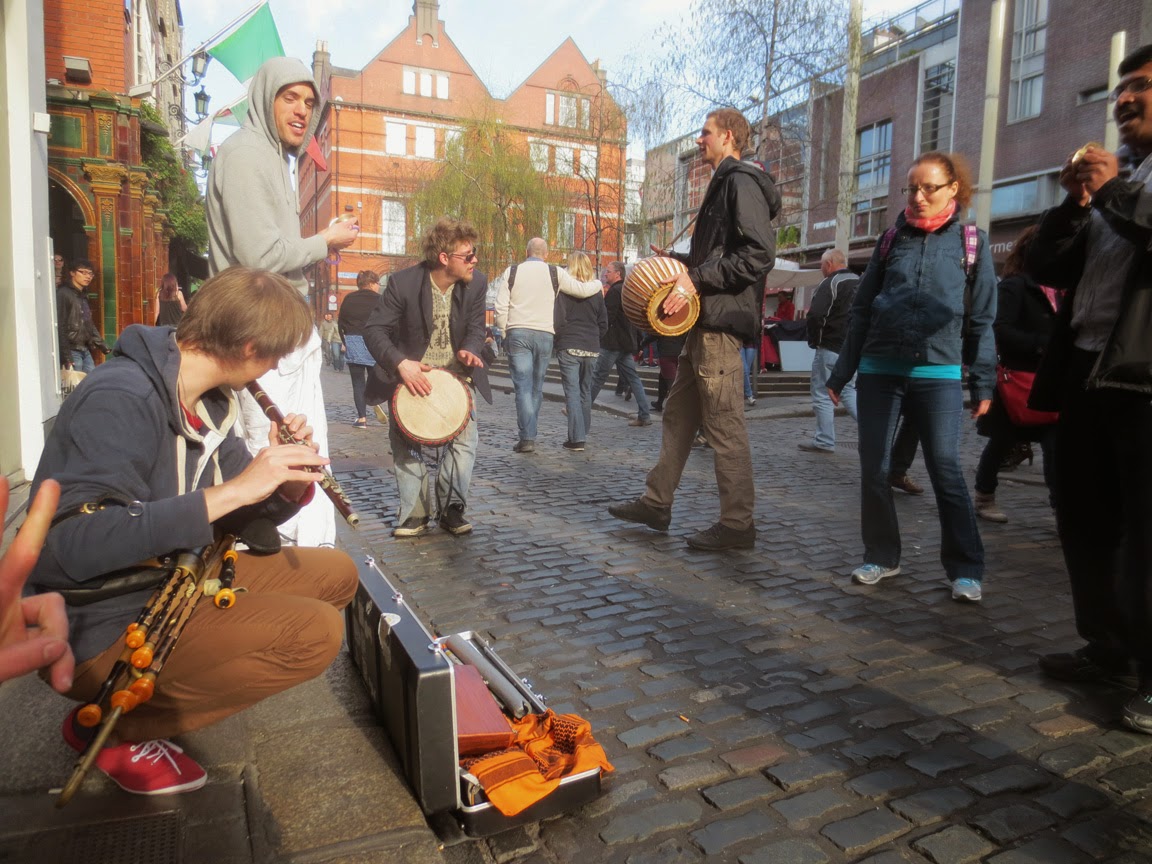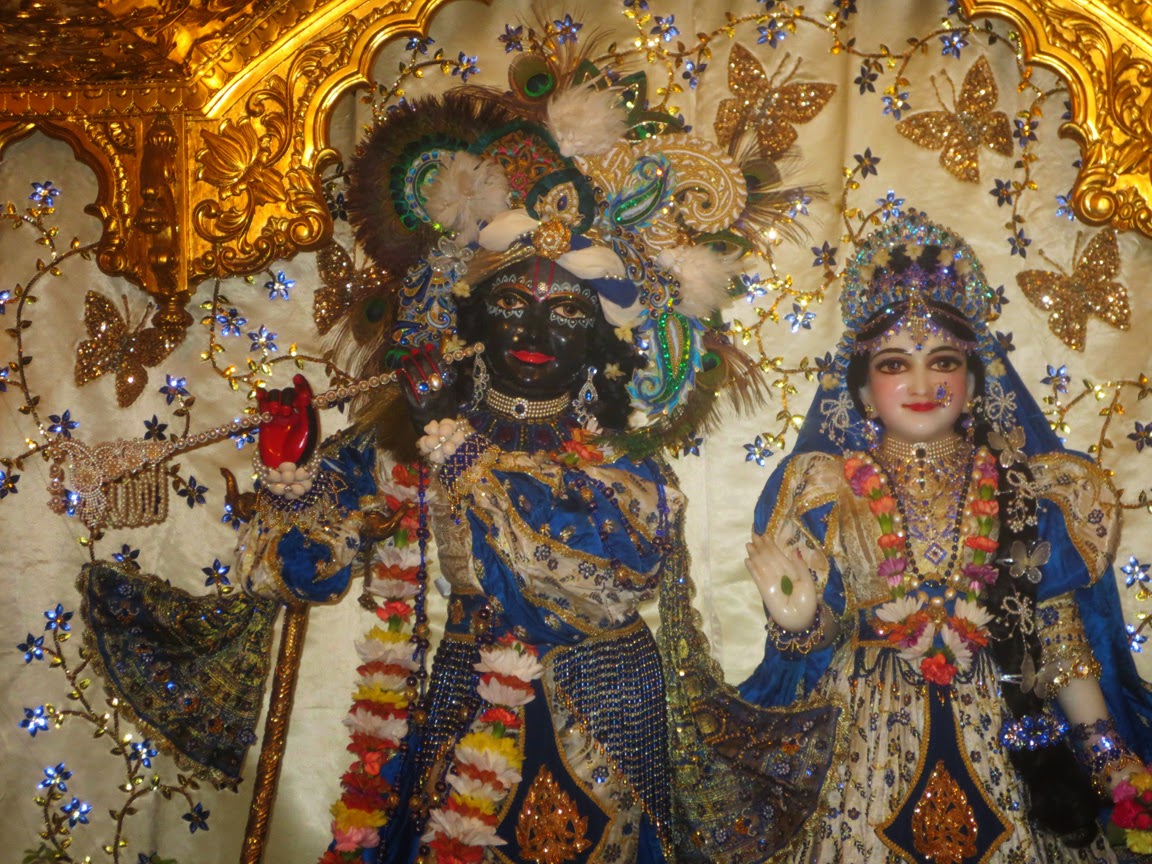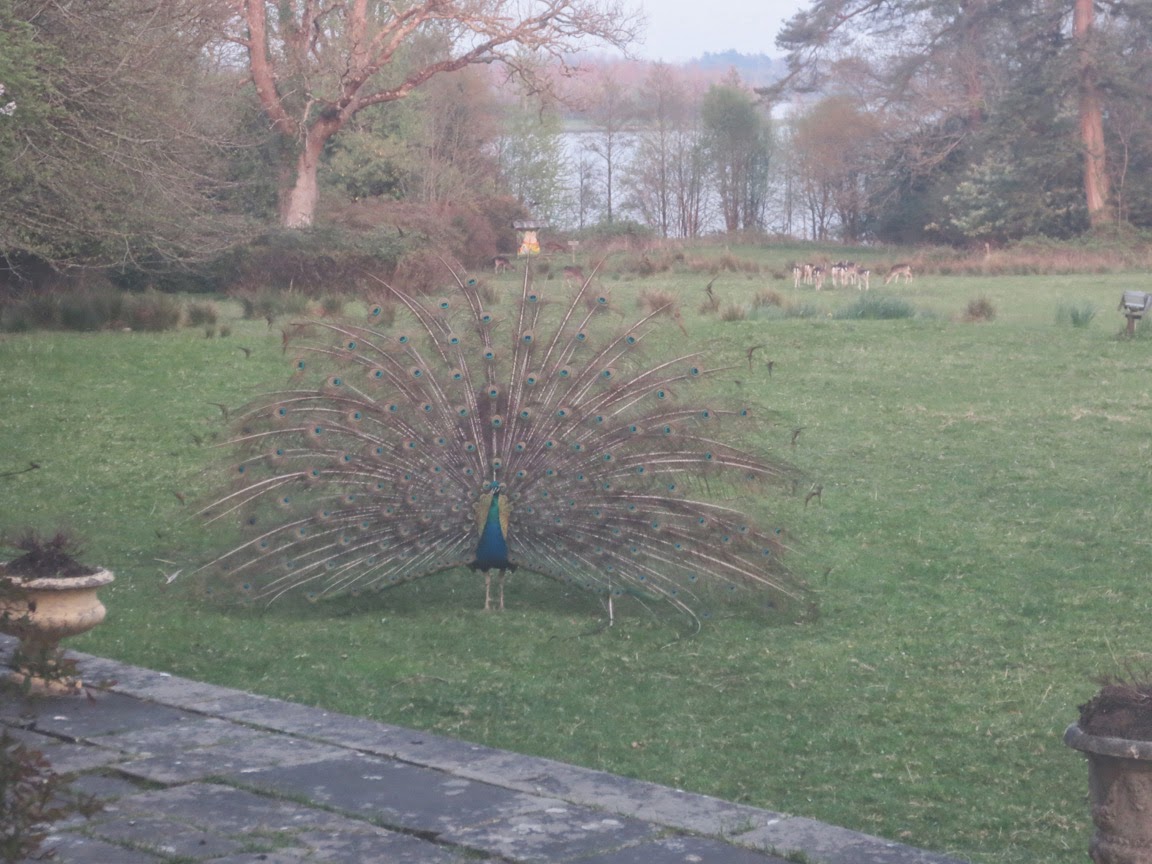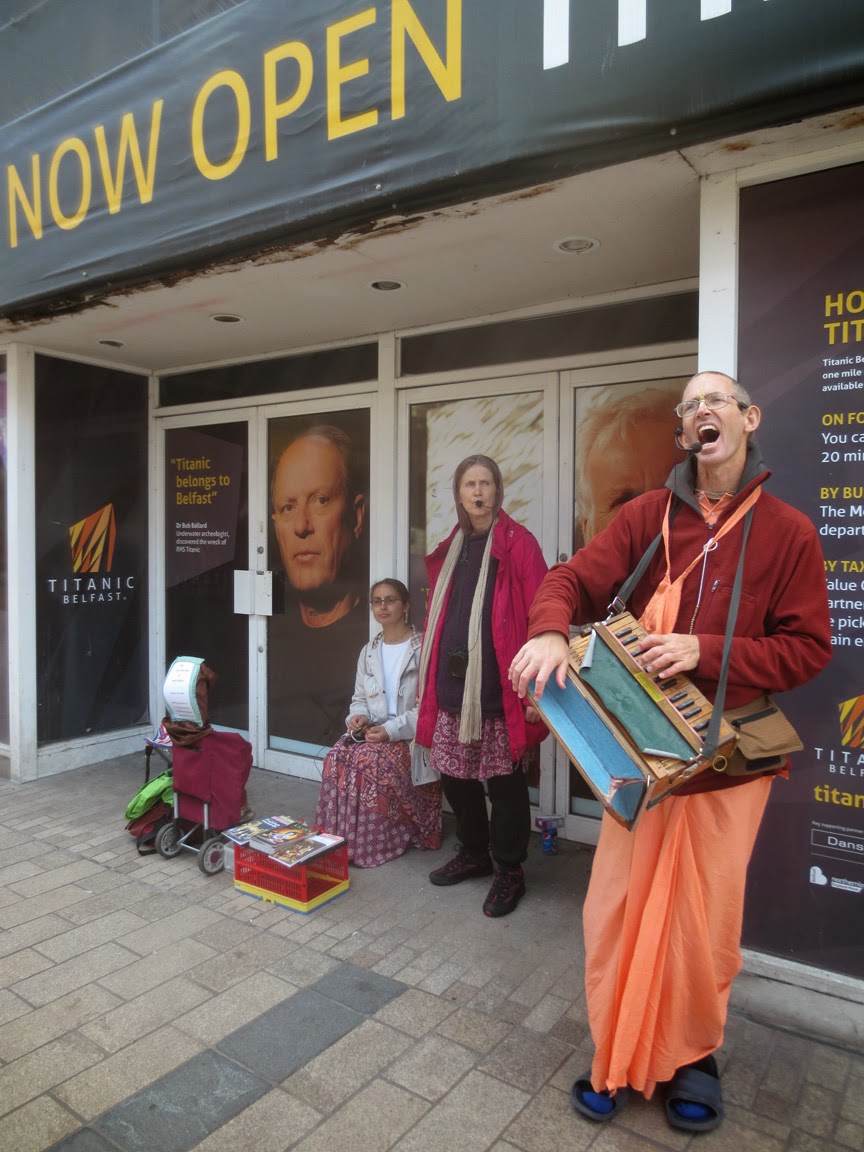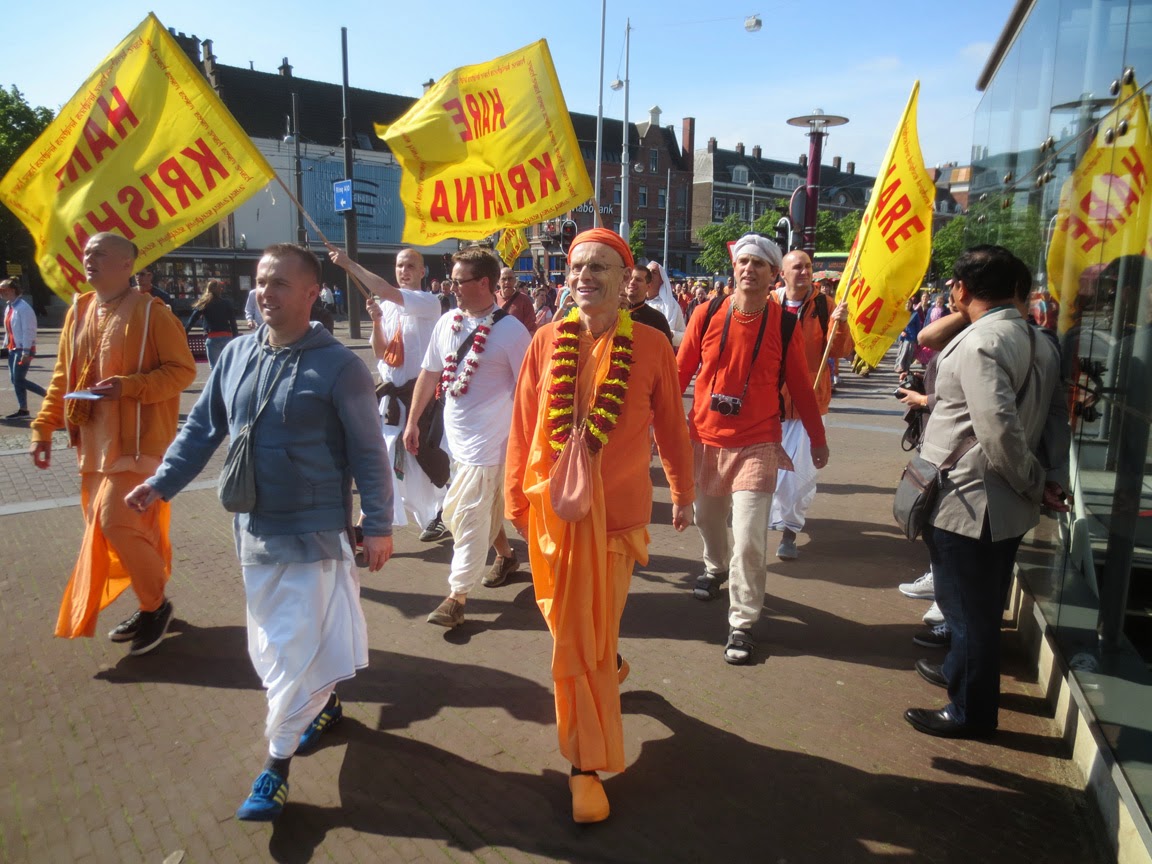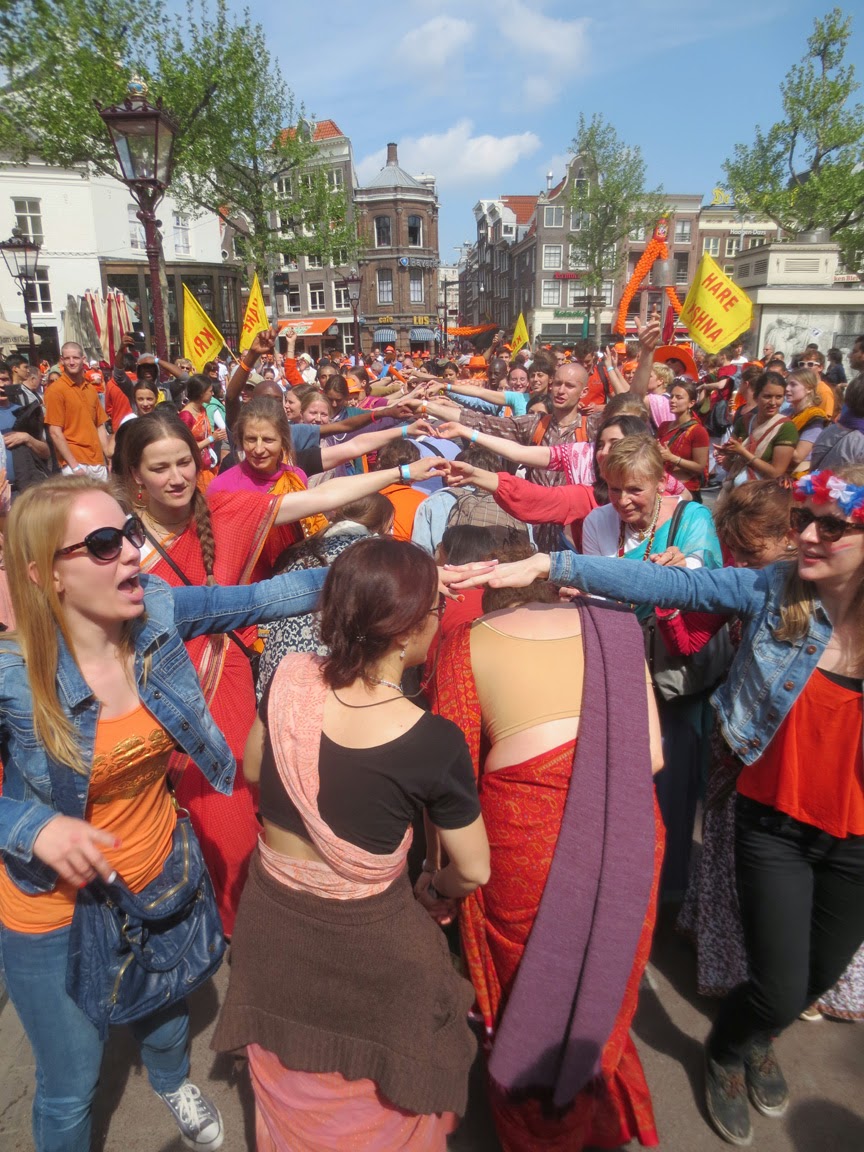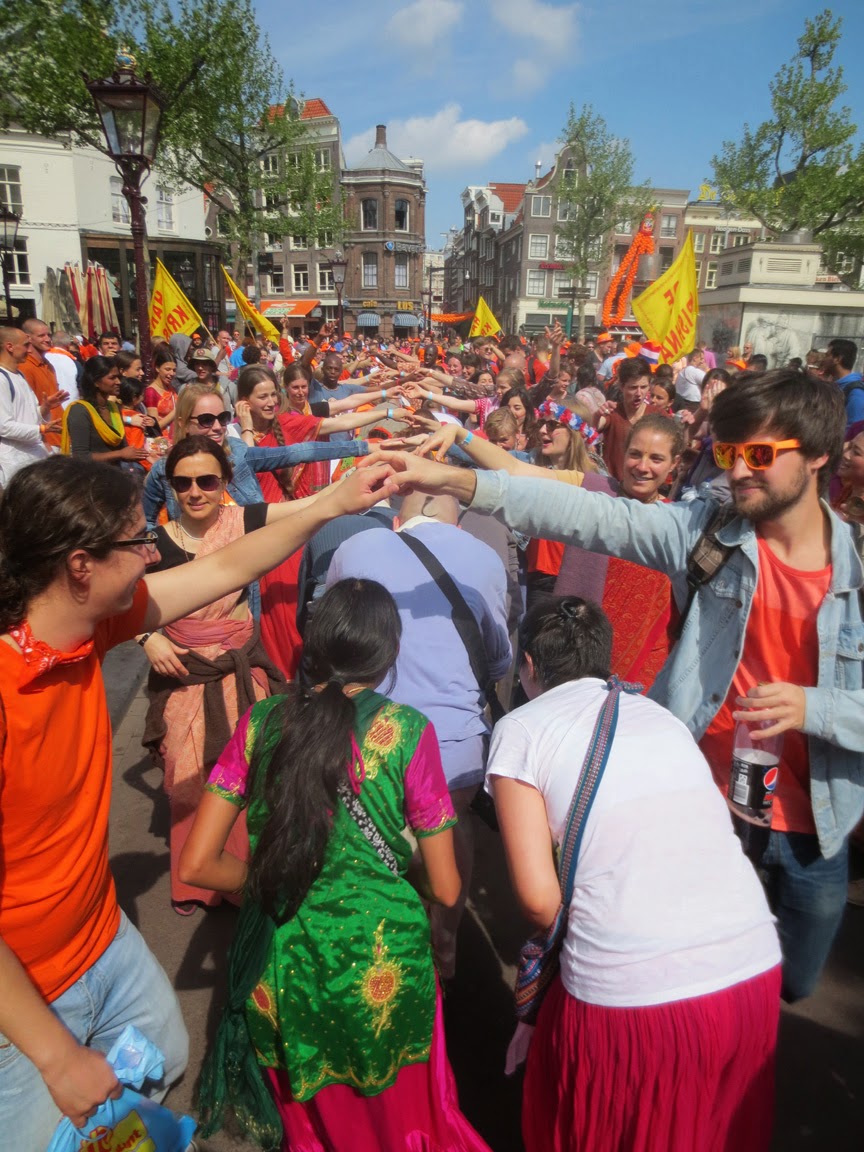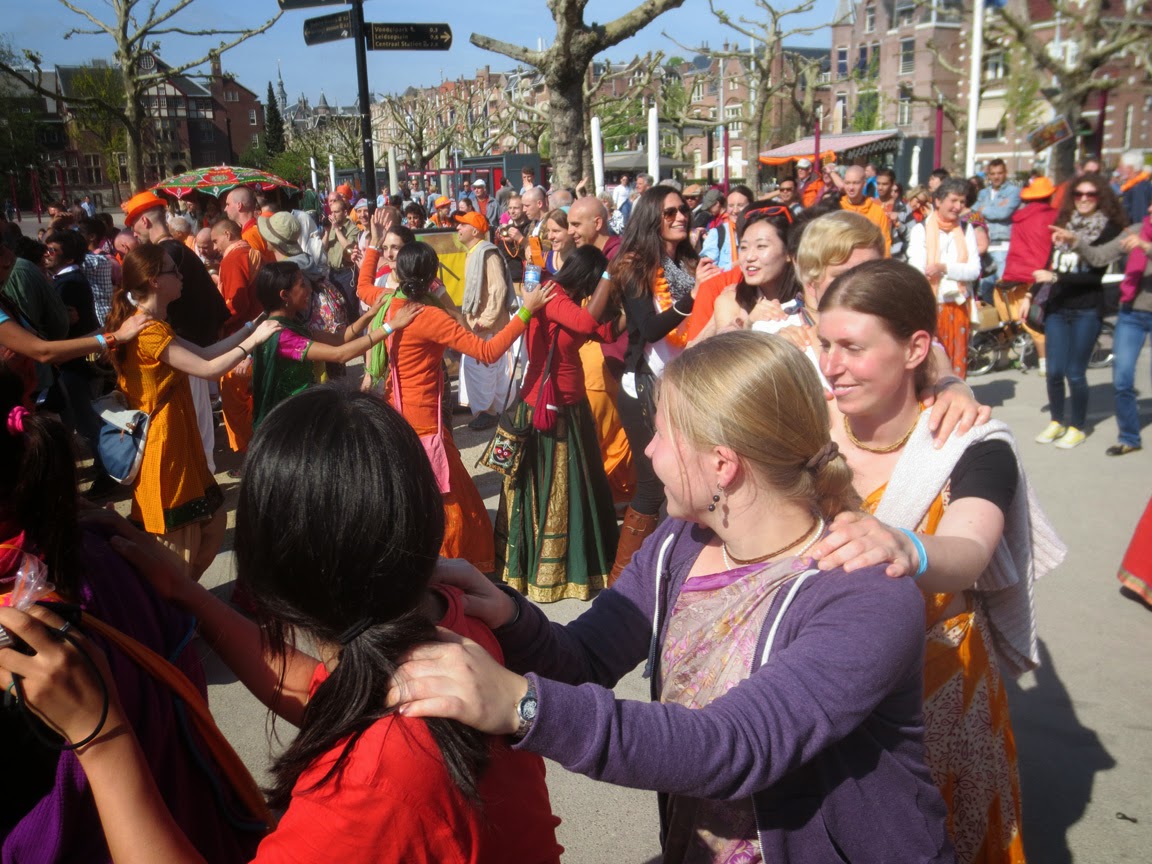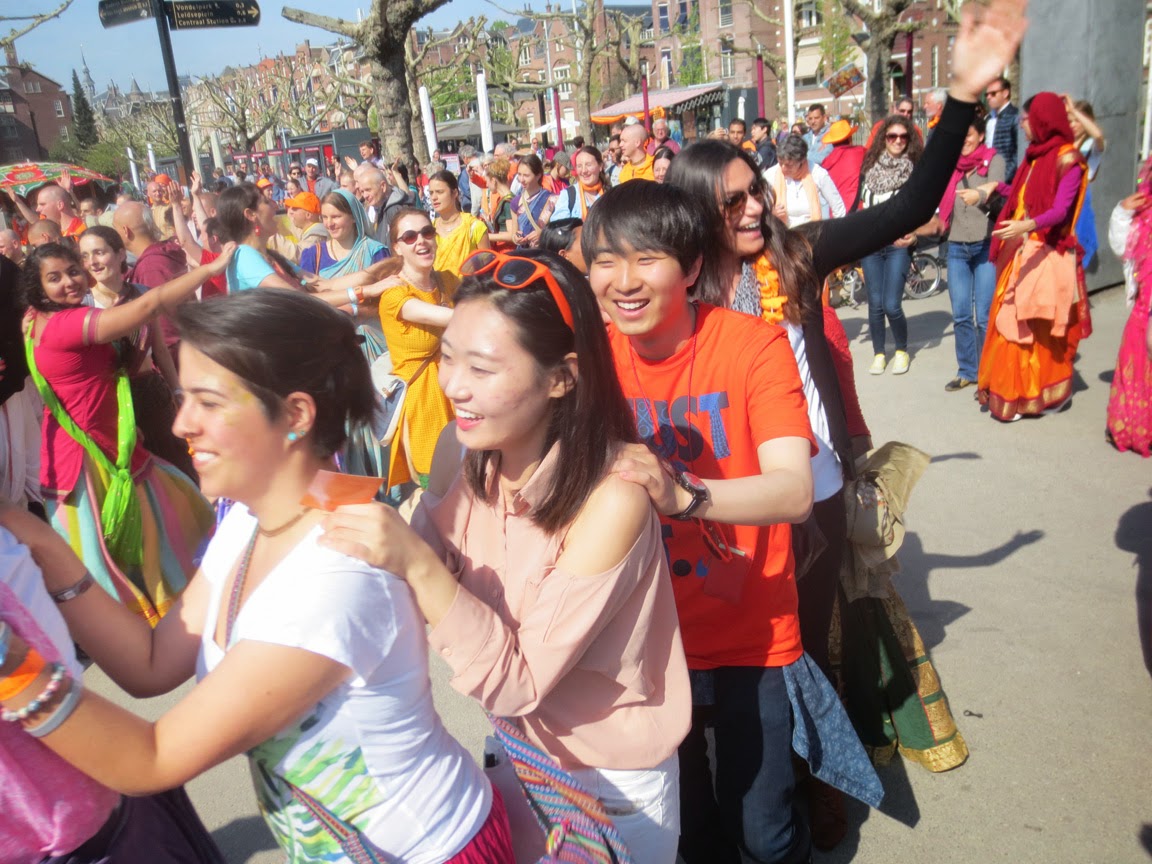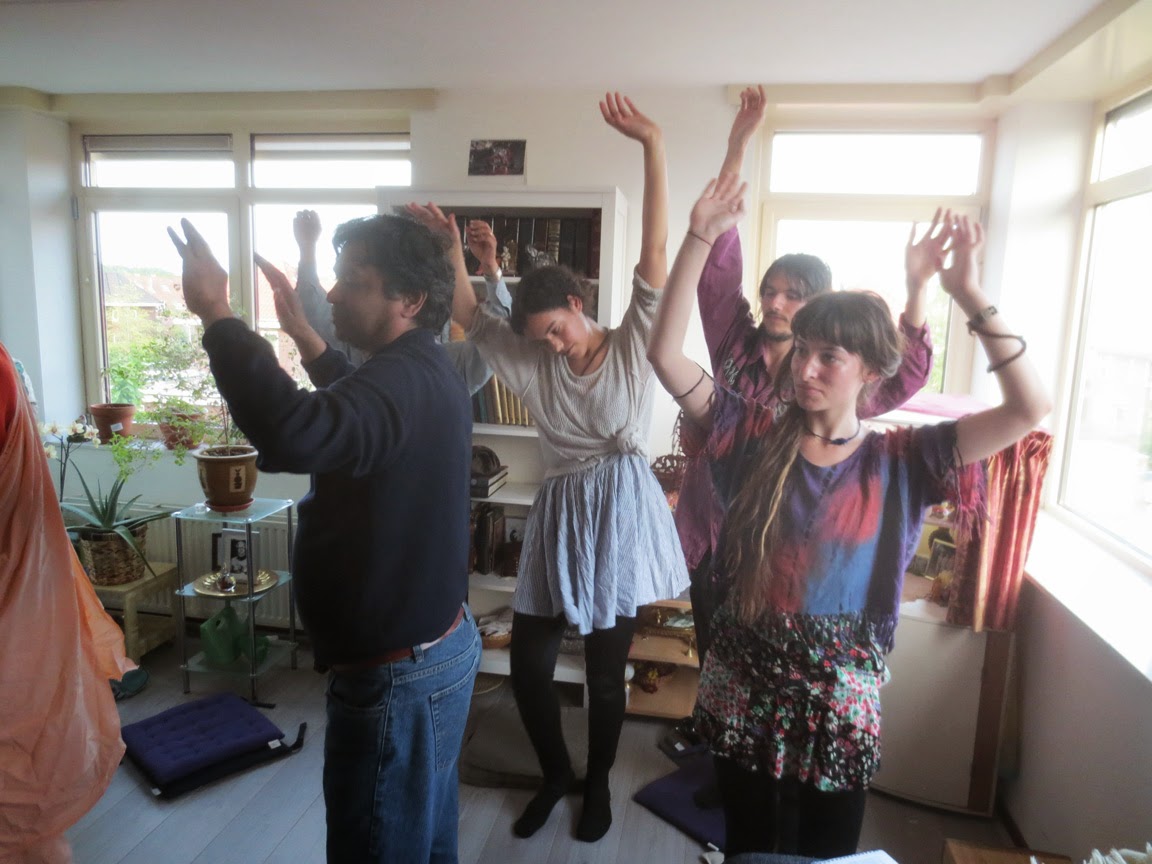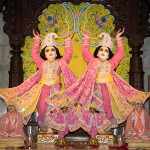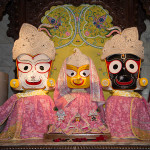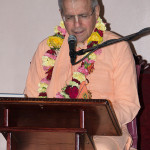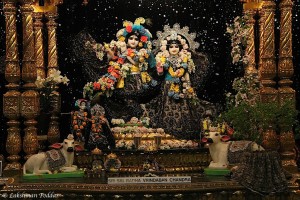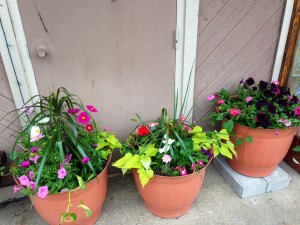HG Vishvambhar Prabhu / SB 10.60.40
HG Narottamananda Prabhu / SB 10.60.39
→ Kalachandji's Audio Archive
See The Beauty – Melissa Ohden – Abortion Survivor
→ ISKCON News
Another Block on the ToVP Dome
→ ISKCON News
ISKCON Scarborough- Recently uploaded videos
→ ISKCON Scarborough
Monday, May 5th, 2014
→ The Walking Monk
Last Day in Halifax
The hearty daffodils stand in all their glory. Even in the dark, early hours, they transcend without sunshine and with mouths wide open. Raccoons screech at each other – a fight no doubt. I can hear them, but I can’t necessarily see them. For years in my travels I’ve heard their sounds, predominantly their whimpering. Then the birds pick up with their morning welcome songs. It’s all awesome, and it really beats the noise of the maddening traffic, when passions kick in and the nocturnal peace that’s punctuated with raccoon party fights is all done. This transition of sound and activity is my observation for many years now on early morning early walks.
Corey and Theresa had us over for lunch. Once again, I’m impressed what a little training has done for younger folks such as the youth. Corey, in particular, travelled with our east coast monks one summer and is now enjoying the lasting and favourable effects. He whipped up this fabulous meal for a group of us. His service mood was excellent. The apartment he and Theresa share is a small oasis of sacred books by Bhaktivedanta Book Trust. They have a modest but beautiful shrine of Krishna deities. They keep a clean place. I see a smooth assimilation of Vedic culture in their lives. I’m happy for this young couple who might otherwise be prone to stay on the grid of sense gratification.
With it being my last day in Halifax, I called on a small ad hoc meeting amongst faithful followers to discuss vision and organization for the sharing of Krishna Consciousness in this neat old city. There’s a rich history here of the acceptance of waves of immigrants at this natural and national port of entry, of taking a major blow when explosives from the harbor went off a century ago, flattening the city, and of a ready response to burying hundreds of corpses, victims of the fateful Titanic. I think we can fit Krishna into the multiple experiences of Haligonians, residents of Halifax.
May the Source be with you!
6 KM
Fascinating Mahabharata Characters online course
→ The Spiritual Scientist
The “Fascinating Mahabharata Characters” course by Chaitanya Charan das covers systematically the biographies of sixteen important Mahabharata characters. Drawing insights from the broad Vedic wisdom-tradition, the course explains their qualities, resolves controversies and demonstrates the perennial relevance of this timeless classic.
The characters covered are:
- Bhishma
- Drona
- Vidura
- Dhritarashtra
- Kunti
- Yudhisthira
- Bhima
- Arjuna
- Nakula
- Sahadeva
- Duryodhana
- Karna
- Draupadi
- Ashwatthama
- Ghatothkacha
- Abhimanyu
To know more about the course, visit www.bhakticourses.com.
What Is The Question Of Mind?
→ Japa Group

When discussing the correct method of chanting japa, Srila Prabhupada generally advised his disciples to "just hear the name." In Bhagavad-gita, Sri Krsna orders Arjuna to do the same, tat srnu, "Just hear Me." Once a disciple told Srila Prabhupada that it is very difficult to control the wandering mind during japa. In reply, Prabhupada said:
From Art Of Chanting Hare Krsna by Mahanidhi Swami
Why are there differences among different religions?
→ The Spiritual Scientist
Different countries have different water, air, mountains, forests, eatables and clothing. Because of this, the people of these places have naturally developed different physiques, complexions, customs, clothing and food. Similarly, the peoples' mentality will differ. And thus various people's ideas of God, though being basically similar, will differ in details. When men in various countries surpass the uncivilized stage and progress to the civilized stage, the scientific stage, the moral stage and the devotional stage, they will develop differences, in language, dress, food, and mentality. This gives rise to difference in the mode of worship of God. Considering the matter objectively, there is no harm in secondary differences. If there is agreement concerning the essential nature of God and His worship, there should be no obstacle in attaining the same result. Thus Mahaprabhu has instructed that we should instruct everyone to worship the pure form of the Lord, but at the same time we should not criticize others' modes of worship.
Because of the above reasons, we see the following differences amongst the religions of different countries.
1. difference of teachers or prophets
2. difference in worshipper's mentality and consequent expression of reverence. 3. difference in procedures of worship
4. difference in conceptions of God
5. difference in God's name and statements due to difference in language
- Chaitanya Shikshamrita, Bhaktivinoda Thakura,
Urban Yoga
→ Ramai Swami
The Urban Yoga program in Melbourne is still going well. It is held on the next floor up from our Crossways restaurant downtown. The devotees teach yoga as well as having kirtan and lecture nights.
The greatest thing
→ KKSBlog
bahūnāḿ janmanām ante
jñānavān māḿ prapadyate
vāsudevaḥ sarvam iti
sa mahātmā su-durlabhaḥ
It is a rare person who, after many many births, is coming to the point where they say,”Krsna is everything,” or “Krsna is the priority in my life.” So initiation stands for that – that Krsna becomes the priority. So that is wonderful. That is actually the greatest thing.
After so many lifetimes of being distracted by so many secondary things, now the most wonderful, ultimately the only wonderful objective, has become the priority in our life. So it is a glorious moment. It is a blissful moment. It is a happy moment. It is a time when we become finally relieved from being misguided and we are taking our steps on the spiritual path which is a blissful path. It is a path that brings us more and more auspiciousness with every step that we take.
So in this way, it is indeed a very important and significant moment.
Travel Journal#10.8: Dublin, Northern Ireland, London, Holland
→ Travel Adventures of a Krishna Monk
By Krishna-kripa das
(April 2014, part two)
(Sent from Newcastle upon Tyne, England, on May 7, 2014)
Thanks to Gopalacarya Prabhu (Govindadvipa), Kevin (Govindadvipa), Premarnava Prabhu (Dublin), Shelina (Govindadvipa), Syamamayi dd (Belfast), and Bhagavati Dasi (Belfast), and Madhava Gauranga Prabhu (Rotterdam) for their kind donations which allow me to continue traveling and promoting the public congregational chanting of the holy name. Thanks to Vicaru Prabhu for the nice pictures of the harinama in London.
Govindadvipa, the Krishna Island in Northern Ireland
In descriptions of Krishna’s abode, Goloka Vrndavana, in the spiritual world, animals such as deer and peacocks are found, and these animals can be found at Govindadvipa as well.
One nice devotee lady, Karunesvari dd, who plays the harmonium, did an excellent job singing much of the time.
My friends Kevin and Shelina, who I met doing Bhakti-sastri in Mayapur, came out with their son, Tukarama, demonstrating that harinama can be a family affair.
To see the photos which I did not include in this blog, many of which are from the King’s Day harinama in Amsterdam, click on the link below or copy it to your web browser [note that the unused pictures follow the used pictures in the album]:
bhaktas dancing and chanting
with upraised arms.
They appear to be
having a lot of fun.
Harinamais actually
a recreation only.
It is profoundly
grave spiritual prayer
more holy than
mystic yoga,
practice of austerity,
or study of the Vedas.
It is so powerful that
it pleases Krishna
very much yet
it is performed
in a lighthearted
way, bringing bliss to the chanters.
This is the practice
of harinama.It is
the heaviest yajna
yet the performers do it in joy.”
devotees dancing and chanting
with upraised arms.
Although they are only four
they look like a strong attractive
presence as many devotees
as possible should go out
on harinamatogether.
A large number inharinama
breaks the modes
of nature, and the holy
name becomes dominant
over the local
mundane forms. But
if only four or five
or six go out together, they
can transform the
air space and bring
the spiritual world
by the great chant
for deliverance.
Who knows
the power of harinama,
how it is changing the world for the better
and how it is spreading its influence.
By the will of Krishna anything is possible.”
Janananda Goswami:
Chandan Yatra, May 2, New Dvaraka, Los Angeles
Giriraj Swami
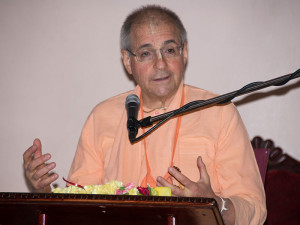 Giriraj Swami read and spoke from Sri Caitanya-caritamrta Madhya-lila 4.105-161.
Giriraj Swami read and spoke from Sri Caitanya-caritamrta Madhya-lila 4.105-161.
TEXT
gopinatha amara se eka-i anga haya
inhake candana dile habe mora tapa-kshaya
TRANSLATION
“There is no difference between My body and Gopinatha’s body. They are one and the same. Therefore if you smear the sandalwood pulp on the body of Gopinatha, you will naturally also smear it on My body. Thus the temperature of My body will be reduced.”
PURPORT by Srila Prabhupada
Gopala was situated in Vrindavana, which was far from Remuna. In those days, one had to pass through provinces governed by the Muslims, who sometimes hindered travelers. Considering the trouble of His devotee, Lord Gopala, the greatest well-wisher of His devotees, ordered Madhavendra Puri to smear the sandalwood pulp on the body of Gopinatha, which was nondifferent from the body of Gopala. In this way the Lord relieved Madhavendra Puri from trouble and inconvenience. —Cc Madhya 4.160
COMMENT by Giriraj Swami
“So, this is the beautiful relationship between the Lord and His pure devotee. The pure devotee is ready to take any trouble for the pleasure of the Lord: in fact, he doesn’t take it as trouble—he takes it as pleasure. Even though externally it may be very difficult, internally he takes it as pleasure, because he is able to serve his Lord. But the Lord, knowing the consciousness of His devotee, wants to serve His devotee by saving him the difficulty. This reciprocation is important for us to know because it will serve as a guideline for how we should act, and it will inspire in us greater appreciation for the Lords’ kind and merciful nature. Even though He is the Lord and is meant to receive all service, He is also a person and wants to reciprocate with His loving servant. If the devotee passes a test, then the Lord doesn’t want him to endure any more pain than necessary.”
May 6th, 2014 – Darshan – Chandan Yatra – Day 5
→ Mayapur.com
The post May 6th, 2014 – Darshan – Chandan Yatra – Day 5 appeared first on Mayapur.com.
Prabhupada Letters :: Anthology 2014-05-06 13:46:00 →
Prabhupada Letters :: 1968
Prabhupada Letters :: Anthology 2014-05-06 13:44:00 →
Prabhupada Letters :: 1969
Prabhupada Letters :: Anthology 2014-05-06 13:41:00 →
Prabhupada Letters :: 1970
Prabhupada Letters :: Anthology 2014-05-06 13:38:00 →
Prabhupada Letters :: 1971
Prabhupada Letters :: Anthology 2014-05-06 13:35:00 →
Prabhupada Letters :: 1973
Prabhupada Letters :: Anthology 2014-05-06 13:33:00 →
Prabhupada Letters :: 1973
Prabhupada Letters :: Anthology 2014-05-06 13:31:00 →
Prabhupada Letters :: 1973
Prabhupada Letters :: Anthology 2014-05-06 13:30:00 →
Prabhupada Letters :: 1973
Observing Ganga-saptami
→ SivaramaSwami.com
The post Observing Ganga-saptami appeared first on SivaramaSwami.com.
Harinama under the rain in Pryluky, north-central Ukraine (Album 27 photos)
→ Dandavats.com
 Pryluky is a city located on the Udai River in the Chernihiv Oblast, north-central Ukraine. Read more ›
Pryluky is a city located on the Udai River in the Chernihiv Oblast, north-central Ukraine. Read more › Taking Shape
- TOVP.org
The TOVP is looking more like a temple and less like a construction site with each passing day. Especially now since the altars and brickwork are progressing!
The post Taking Shape appeared first on Temple of the Vedic Planetarium.
Pankajanghri Prabhu at ISKCON Mayapur on 2014-05-03
→ Gouranga TV - The Hare Krishna video collection
Pankajanghri Prabhu at ISKCON Mayapur on 2014-05-03
Srimad Bhagavatam Class Schedule
→ The Hare Krishna Movement
ISKCON Scarborough – Special Mother’s day weekend programs- May 9th to 11th 2014
→ ISKCON Scarborough
Hare Krishna!
Please accept our humble obeisances!
All glories to Srila Prabhupada!
All glories to Sri Guru and Sri Gauranga!
We would like to warmly invite you and your family to join us for the wonderful Mother’s day weekend celebrations from May 9th (Friday) to May 11th (Sunday) at ISKCON Scarborough.
During this weekend, we would take the opportunity to honour and thank all the Mother's for their selfless, tireless and unconditional service.
May 9th 2014 – Friday - Special guest speaker - HG Shyamasunda dasa (ACBSP). Program starts at 6.45 PM
May 10th 2014 – Saturday - Special Mother’s day class will be given by Her Grace Sita Thakurai DD. Program starts at 6.45 PM
May 11th 2014 – Sunday – Grand Mother’s program - Special Mother’s day class will be given by HG Jagannath Misra das. Program starts at 10.40 AM.
Bio Data of HG Shyamasundara dasa:
- Initiated Brahmana (Vedic priest), disciple of A.C. Bhaktivedanta Swami Srila Prabhupada since 1976.
- Student of Vedic Astrology since 1977.
- Given scholarships by the Bhaktivedanta Institute and Bhaktivedanta Book Trust to study Vedic Astrology in India.
- Trained in India for 6 years with recognized pandits of Jyotish
- An authority in all the main branches of Vedic Astrology: Ganita (mathematical calculations), Jataka (Natal), Prashna, Muhurta and Nimitta.
ISKCON Scarborough
3500 McNicoll Avenue, Unit #3,
Scarborough,Ontario,
Canada,M1V4C7
Email Address:
iskconscarborough@hotmail.com
website:
www.iskconscarborough.com
Sunday, May 4th, 2014
→ The Walking Monk
May the Fourth
After a leg journey’s venture along the North West Arm of Halifax Harbour, I decided to sit a few minutes out at the Saint Mary’s Boat Club dock. I was there in meditative pose on a bench, and without him noticing me, I observed a Mariner coming in to the shore. I guess that’s what you could call a guy in a kayak. He came to dock and took meticulously to the care of his boat. He hosed it down and set it upright after propping it on some stilt stands, and then slipped it over to wash the salt water. Then he wiped it dry very lovingly and did so twice by flipping it again. He executed the same for his oars, and all this was done before he set it in place stacked up with hundreds of other kayaks. Such devotion.
I wish I had that much bhakti, devotion, for my paraphernalia. God knows, as a monk, I own little, but whatever I have, I should treat it like gold, like this guy treats his sporting goods.
Not but two hours later, I saw Nitai Ram, who is such a real brahmin (priest) treat his paraphernalia with similar prudence and care. Nitai Ram, along with Fernanda and Nina, set up this beautiful havan kund (small fire arena) for a fire ceremony on Nina’s initiation. Nitai’s execution of the ritual was just fantastic. It was impressive, like the kayaker’s handling of his equipment.
I’d like to congratulate Nina on her new spiritual name which is, Nirmala. It sounds like Nirvana. It means one without pride. Her parents drove all the way from Saint John, New Brunswick.
My second major destination was to a kirtan kattha session (chant and talk) located on Hollis Street across from the Wired Monk Café. I avoided cars as much as possible on this gorgeous, fresh and sunny day. While on foot at Robie Street, two young guys across the road were sitting on their lawn chairs in the front yard sipping pop. They beckoned me to come to see them, so I crossed the street. We started to chat. They were interested in my monkism, and finally invited me into their home to go through their whole house and in to their back yard, and to “bring in good energy” as they put it.
They told me they are musicians and I told them I do Sanskrit mantras. Spontaneously they took to recording my recitation of the mangala charana mantras, while Michael hit the keyboard for a sitar twang. And the other fellow (forgot his name), made percussion sounds. It was a jamming on the spot session for sure.
On this day I saw devotion coming from different directions; a little bit like, if I could use the term, “angles from angels”.
May the Fourth be with you!
10 KM
Power Of The Hare Krsna Mantra
→ Japa Group
Letter to Damodara
January 10, 1971
The first austerity
→ KKSBlog
(Kadamba Kanana Swami, 29 April 2014, Radhadesh, Belgium, Srimad Bhagavatam 6.4.49-50)
 Our purposes are fixed and we do not let obstructing circumstances to block us permanently. Somehow or other, we must go through and to fulfill our purpose – to chant sixteen rounds and to follow four regulative principles – because that is our first austerity, to chant these rounds and to follow these principles.
Our purposes are fixed and we do not let obstructing circumstances to block us permanently. Somehow or other, we must go through and to fulfill our purpose – to chant sixteen rounds and to follow four regulative principles – because that is our first austerity, to chant these rounds and to follow these principles.
Then, as we see, the austerities do not come alone. We also need support. It’s not just a matter of the right frame of mind. It is also a matter of favourable conditions so that it becomes feasible and possible. One must protect the rounds. One must put other things out of one’s life and then put the rounds in, otherwise it is not going to happen. One cannot just think, “I’ll see how far I get today.” Then there is a good chance that it won’t work. So chanting sixteen rounds is about making an arrangement to chant sixteen rounds. That is the very first thing and actually so important!
It is not all about a mood and getting absorbed. That comes after. If the arrangement is wrong then how can you get absorbed? First the arrangement has to be in place. When that is all there, then stage two comes, “Yes, how to get absorbed.” I find one thing that helps me is to read a little bit. It’s not that we just to get up and immediately be in the mood, “Okay, let’s get these rounds done! I’m up (shuffling to do things), quickly get stuck in. Then that’s behind me.”
That is one way of chanting. But another way is where I say, “Okay, I’ll read for five or ten minutes.” And I read until I come across something that strikes me. Something that while reading, it strikes me and then I start chanting and that gives some energy to get into the mood. Then the mood starts happening, better. Like that there are impetuses. Ālambham is there, the impetuses in spiritual life that help us to awaken our attraction for Krsna.
New Vrindaban Daily darsan @ May 5, 2014.
→ New Vrindaban Brijabasi Spirit
Please meditate on the youthful couple who, Their love for each other eternally increasing, and the hairs on Their fair and dark forms erect in ecstasy, are now intoxicated by the sweet nectar of Their amorous pastimes in this forest grove.
[Source : Nectarean Glories of Sri Vrindavana-dhama by Srila Prabodhananda Sarasvati Thakura, Sataka-2, Text-32, Translation.]
From the New Vrindaban Garden: ECOV & Amish Auction 5/5/14
→ New Vrindaban Brijabasi Spirit
Greetings From the Garden:
This week as I was harvesting asparagus I was asked, “what do you do with all of the vegetables that are picked from the garden?”. What a great question. The vegetables, fruits, and flowers grown here at New Vrindaban are used for the deity kitchen, prasadam, and Govinda’s Restaurant. The organization responsible for the planning, maintenance, and harvesting is ECOV. ECOV is a 501(c)3 nonprofit dedicated to cow protection, local production of food, sustainable housing, alternative energy production and energy conservation. We are also working towards having active teams of oxen, planting 1000 fruit and nut trees and building earth sheltered low impact housing using recycled or locally produced materials. ECOV stands for Earth, Cows, Organics, and Village. Check out the ECOV website
This year we are starting many new garden projects and were in need of garden tools. I have always enjoyed a good auction so when Madhava Gosh suggested we attend an Amish consignment auction in search of tools I was quite intrigued. We left early in the morning for the Captina Auction house in Monroe County, OH. I have been to many animal and produce auctions before, therefore I thought I would know what to expect. I was wrong. There was an almost even mix of Amish and English (English is what the Amish call non Amish people). Horses and buggies surrounded the auction building. The amount and variety of auction items was mind blowing. Large carts filled with tools, buildings, furniture, animals, boats, all things equestrian, tractors, building supplies, trees, hand crafted items, and so much more.
Three auctioneers began the bidding in three locations, it was almost sensory overload deciding which area to watch. We started with the tool carts. It took only a few minutes for the auctioneer to mark Gosh as the dollar man. Or in other words when no one was bidding they could rely on Gosh to pay a dollar for anything that seemed to have at least some value. We were able to get shovels, rakes, boots, and tools for just $1.00. Some items were more expensive than I would have expected, notably pitch forks were going as high as $30.00. I found this odd because I saw a beautiful horse saddle for only $15.00. In a moment of auction weakness I even bid on a deaf puppy (which would have made for an interesting ride home). Luckily I was out bid by a young girl super excited for her $12.00 puppy. In the end we FILLED the van with an assortment of items including a 150 gallon water tank for tree planting, many hand tools, and a very large sorghum & maple syrup evaporator. We had a great day with successful purchases and I can’t wait until next year.
08 May 2014 – Disappearance Day of Sri Madhu Pandita
→ ISKCON Desire Tree
08 May 2014 – Appearance Day of Srimati Sita Devi
→ ISKCON Desire Tree
08 May 2014 – Appearance Day of Srimati Jahnava Devi
→ ISKCON Desire Tree
Sridhar Swami and Mayapur
- TOVP.org
Article written by His Holiness Giriraj Swami
The Mayapur Temple of Vedic Planetarium (TOVP), under construction, recently opened an office in the ISKCON Juhu temple, at Hare Krishna Land in Mumbai. In honor of the occasion, and to further the cause, I thought to share an excerpt adapted from my article “Memories of Sridhar Swami” in my book Many Moons.
In November 2003, Srila Prabhupada’s staunch disciple Sridhar Swami phoned me from Bombay and told me that he was planning to go to Vancouver in April for four to six months. Soon thereafter, however, he sent an e-mail saying that he had been diagnosed with liver cancer and was going to Vancouver immediately to see if he could get a liver transplant, which was his “only hope.” There the tests revealed that his cancer had spread beyond the limit allowed for transplants, and so his “only hope” was dashed, and it seemed like he was soon to leave his body. I phoned Maharaja from Santa Barbara and eventually got him on his cell phone. “Where are you?” I asked. “I’m shopping,” he answered. He seemed so jolly—like always. But then he confirmed my worst fears: “The doctor says that I could go at any time. Phone me back later. We have to talk.”
After that, we would speak every day, usually twice a day. And we had wonderful talks. Then the question arose whether he should go to Mayapur—and when. He decided he would go to Mayapur and concluded that he should go as soon as possible.
He had three desires, he said: “I just want to survive until I reach Mayapur. Then, if possible, I want to live to see the Panca-tattva installed. And then, if possible, I want to live until Gaura-purnima. And then—whatever.” (He meant, of course, “And then—whatever Krishna wants.”) No one knew how much travel Maharaja’s weakened body could bear, but with these three desires in his heart, he flew to London and then to Kolkata, and eventually he arrived in Mayapur.
I wanted to phone Maharaja every day, but the way it worked out with the time difference and all the difficulties in just getting through to Mayapur, we only managed to speak every third day or so. The last time, two days before he left, he was having a good day. The previous day had been a bad one, but the night before, they had given him some additional medication. So when I spoke with him that last time, he was having a good day, and we had one of the best talks I have ever had with anyone in my entire life. We spoke mainly about the Mayapur project and Srila Prabhupada’s mission. It’s really something that I’ll cherish for my whole life—the experience of it and the lessons it contained.
That was Thursday, March 11. The next day, Friday, we installed beautiful brass Deities of Gaura-Nitai in our Carpinteria ashram. They had come from Vrindavan, originally commissioned by Mother Kirtida for Tamal Krishna Goswami. I felt that Their coming was also part of Sridhar Swami’s mercy, because he so fervently desired that the glories of the Panca-tattva be spread and that we build the great temple for Them in Mayapur. So, two representatives of the Panca-tattva had come, and I felt that Their arrival was his desire.
On Thursday I had told Maharaja, “I don’t know if I will be able to phone you again before then, but the Deities have come and we will install Them Friday evening, and by your mercy we’ll try to serve Them and Their dhama.” And now, whenever I look at Their beautiful forms and appealing faces, I feel that we have to do something for Them—we have to build Their wonderful temple, as Sridhar Swami always reminded me.
I think this may have been Maharaja’s main contribution in recent years, at least to me in my service: He impressed upon me—and upon our entire movement—the importance of the Mayapur project, of the “wonderful temple” (adbhuta mandira) that Nityananda Prabhu had desired for the service of Caitanya Mahaprabhu, and that Bhaktivinoda Thakura had envisioned. (One day, when Srila Bhaktivinoda Thakura was chanting japa on the balcony of his house in Godruma-dvipa, he looked across the Jalangi River to Mayapur and had a vision of a transcendental city with a magnificent temple rising like a mountain in its midst.) Maharaja’s whole life was dedicated to Srila Prabhupada, and I think he felt that this was one of Srila Prabhupada’s main desires left to be fulfilled. And he felt that we had to do it—and that we had to do it; it would benefit the whole society, and the whole world. He would quote Ambarisa Prabhu: “This will be the tide that will make all the boats rise.” So, although Sridhar Maharaja left so many wonderful legacies for us in terms of his personal qualities and activities, I think one legacy that may serve to unite the movement and fulfill one of Srila Prabhupada’s main desires is his inspiration to push on the construction of the great temple in Mayapur.
When I was a new devotee, maybe less than two years in the movement, I approached Srila Prabhupada one day while he was getting his massage on the veranda of the Calcutta temple. “Srila Prabhupada,” I said, “I have been thinking about what pleases you most.” Srila Prabhupada was so pure he took every word into his heart. He replied, “Yes.” I said, “The two things that seem to please you the most are distributing your books and building the big temple in Mayapur.” Srila Prabhupada smiled with great appreciation and said, “Thank you very much.”
So, those were Srila Prabhupada’s two main strategies for spreading Krishna consciousness, and Sridhar Swami helped him in both. In his early days, Sridhar Swami was instrumental in developing book distribution in North America. And in his later years, he was very involved with the Mayapur project, planning and raising funds for the great temple. And by Maharaja’s mercy, on Gaura-purnima, standing in front of the Panca-tattva Deities in Laguna Beach, I got the inspiration: “Now it’s time for Mayapur. Sridhar Swami understood that long ago. Now it’s time for you [me] to join the effort, too.” And that was important for me in other ways as well—to let go of the past: “Forgive and forget. Now let’s all work together for Mayapur, for Sridhar Swami, for Srila Prabhupada, to build the wonderful temple.”
When I asked Sridhar Swami how I could help, he requested me to speak about my experiences of Srila Prabhupada related to Mayapur. So, in 1973, when Srila Prabhupada came to Calcutta from England, he was very excited and enthusiastic about Mayapur. Tamal Krishna Goswami had gotten the first land, we had observed the first Gaura-purnima festival there, and now Srila Prabhupada had come with the plans for the first building. There was a detailed discussion, and at the end Srila Prabhupada said, “If you build this temple, then Srila Bhaktivinoda Thakura will personally come and take you all back to Godhead.”
Now I think, “That might be my only hope, so I’d better get to work. We’d better build the Mayapur project, because I don’t know how else I will ever get back to Godhead.”
His Holiness Sridhar Swami has given me a lifetime of work in service to Srila Prabhupada. Although jivo va maro va, to live or die is the same for a devotee—and certainly that was true of Maharaja—my own feelings are mixed. I think, “He has left so much service for me, given me so many instructions. So I must stay and execute his mission.” I think the same about Tamal Krishna Goswami. Even though part of me misses them terribly and wants to be with them, mainly I think, “They left me so many instructions. I have so much service to do for them here.”
Of course, how long we have to do what they have asked—what they would want—all depends on Krishna. Therefore, whatever time we do have left we should use in the best possible way—in Krishna consciousness.
The post Sridhar Swami and Mayapur appeared first on Temple of the Vedic Planetarium.
Mumbai for Maypaur
- TOVP.org
Mumbai being the largest metropolis of India, Srila Prabhupada endeavored enthusiastically and established a large temple at Juhu Beach. Mumbai temple has influenced the preaching of ISKCON in India greatly. Srila Prabhupada’s vision was that the congregation and life members of Mumbai can very easily establish the city of Mayapur by building the TOVP and therefore he said, ” Mumbai is my office, Vrindavan is my home, and Mayapur is my place of worship.”
For the last year the TOVP fundraising team has diligently worked and made presentations to the ISKCON India leaders and in return is receiving enthusiastic feedback and commitment from the entire India Yatra to participate in the fundraising endeavors. Mumbai temple president His Grace Braja Hari Prabhu, Zonal Secretary His Grace Devakinandan Prabhu, Sriman Bhima Prabhu, and the local GBC His Holiness Gopal Krsna Maharaj have all together blessed the TOVP fundraising activities by providing a very nice office at the Juhu temple for this purpose.
The TOVP office is located above the life membership office, and the Grand Opening was celebrated by the presence of the above leaders with a Guru puja to Srila Prabhupada and enthusiastic kirtan of hundreds of resident devotees. This auspicious celebration commenced on Sunday morning, April 27th, 2014. We thank the leaders of the Mumbai Yatra for their devotion to the TOVP project and hope to organize many fundraising events there in the near future.
The post Mumbai for Maypaur appeared first on Temple of the Vedic Planetarium.
Nrsimha Caturdasi – Tuesday, May 13, 2014
→ The Toronto Hare Krishna Temple!
Schedule (subject to change):
6:00pm - 6:30pm: Kirtan (Arati)
6:30pm - 6:35pm: Welcome and Announcements
6:35pm - 7:30pm: Discourse on Lord Nrsimha by HG Vaisesika Prabhu
7:30pm - 8:00pm: Abhisheka (Bathing Ceremony)
8:00pm - 8:30pm: Kirtan (Arati)
8:30pm - onwards: Vegetarian Feast
Please join us on this auspicious occasion with your entire family and please stay tuned for the many festivities during this month!


